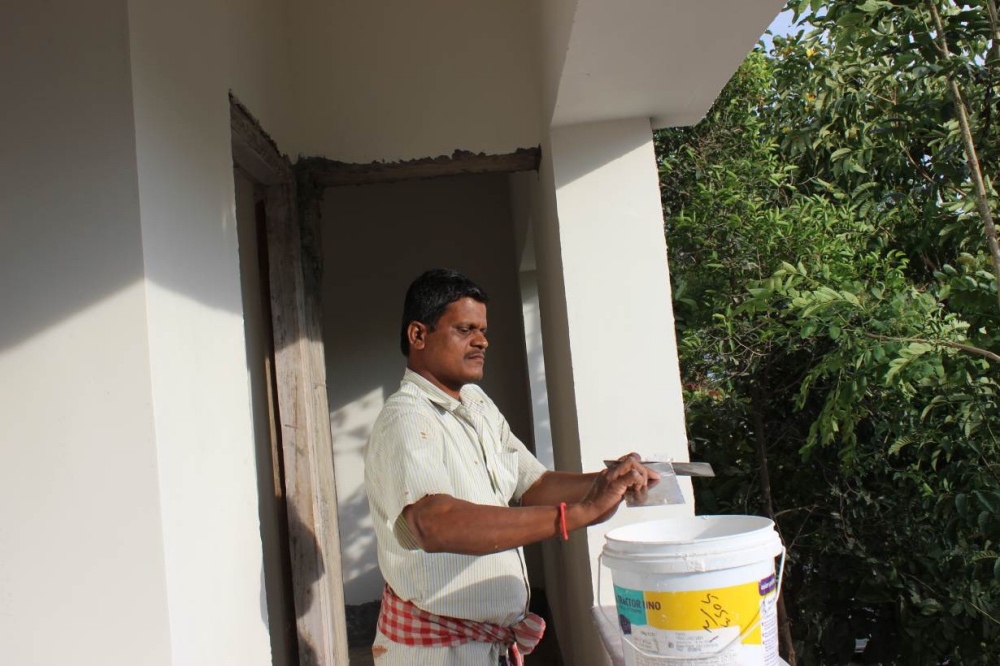
MANIPADMA JENA, of Thomson Reuters Foundation, looks at how rising heat is changing lives in the Indian state of Orisha…
Bhubaneswar, India
Thomson Reuters Foundation
“This extreme heat we now see is no less than a sly thief,” said Murali Sahoo, a building painter in eastern India, as he washed his buckets and brushes at the end of another sweltering work day.
A decade ago, a week’s work painting could bring in 6,000 rupees ($US84), the 43-year-old said.

Murali Sahoo, a building painter in Bhubaneswar, in eastern India’s Odisha state, prepares a wall of a new building for painting, on 9th November. PICTURE: Thomson Reuters Foundation/Manipadma Jena
But over the last five years, increasingly blistering summer temperatures in his home state of Odisha mean working all day is no longer possible, even if he starts at 7am to get a jump on the heat.
“Today my weekly earnings have fallen to just 2,500 rupees ($35), a measly 350 rupees ($5) a day. How can a family survive on this?” asked Sahoo, the father of two boys.
“Today my weekly earnings have fallen to just 2,500 rupees ($35), a measly 350 rupees ($5) a day. How can a family survive on this?”
– Murali Sahoo, painter
As climate change brings ever-more-wilting heat in some of the world’s already hot spots, the future for outdoor workers like Sahoo may be bleak, scientists say.
If greenhouse gas emissions continue to grow at current rates, by 2100 Odisha will get as many as 48 extremely hot days every year, up from only 1.5 such days in 2010, warned the Climate Impact Lab, a non-profit consortium of scientists, in a report released this month.
The study’s researchers classified a day as extremely hot if the outside temperature reaches above 35 degrees Celsius (95 degrees Fahrenheit).
The report, on heat deaths in India, was conducted in collaboration with the Tata Centre for Development at the University of Chicago and examined the human and economic costs of climate change and weather shocks in India.
“Weather and climate shape India’s economy and society,” said Amir Jina, an environmental economist at the University of Chicago’s Harris School of Public Policy and one of the authors of the study.
“Temperature and precipitation affect diverse outcomes such as human health, labour productivity, agricultural yields, crime, and conflict,” he told the Thomson Reuters Foundation via email.
The study projected that average summer temperatures in Odisha will go from about 29 degrees Celsius (84 degrees Fahrenheit) in 2010 to over 32 degrees Celsius (89 degrees Fahrenheit) by 2100.
That would give Odisha the biggest jump in extremely hot days of all of India’s 29 states.
The national average increase will be from 24 degrees Celsius to about 28 degrees, researchers said.

A scene in Odisha where rising heat is predicted to cause economic issues as people find it harder to find work. PICTURE: Saheb Sansowa/Unsplash
Meteorologists point to the state’s location, its geographical features – such as its 480-kilometre-long coastline – and the rise of concrete buildings and asphalt roads in its towns as reasons it can become particularly hot and humid.
As temperatures soar, the study said, Odisha’s economy will suffer as people find it increasingly difficult to work.
No one has yet calculated what rising heat might do to the state’s productivity, Jina said. The Climate Impact Lab plans to provide those projections in a later study.
But a report released by the United Nations’ International Labour Organization in July predicted that, by 2030, India as a whole could lose nearly six per cent of working hours to heat stress.
That would be the equivalent of 34 million full-time jobs, the ILO said.
Extreme heat also can be deadly, health experts warn.
Ambarish Dutta, an Odisha expert at the Indian Institute of Public Health in the state’s capital Bhubaneswar, said in Odisha the “killing effect” kicks in when the ambient temperature reaches over 36.5 degrees Celsius.
In the decade up to 2017, a total of 630 people died as a result of heat waves in Odisha, a state where nearly three-quarters of the working population is in the informal labour sector, most of them working outdoors, according to government data.
But by the end of the century, the heat-related death toll could reach as high as 42,000 per year in Odisha, the CIL study predicted.
Income inequality is partly to blame for the state’s vulnerability to the rising heat, said Jina, the environmental economist.
On average, a person in India starts investing heavily in cooling technologies such as air-conditioning once they make at least 983,000 rupees ($US13,700) a year, noted another Tata Centre for Development study published last month.
Government data shows that in Odisha the annual per capita income is much lower, at 75,800 rupees (just over $US1,000), putting air conditioning out of reach for most people.
“The capacity to adapt better is proportional to higher incomes,” Jina said. Only with more money can people buy air conditioning and make changes to their homes that “may offer better protection”, he said.
There is still time to stop rising heat from destroying lives and livelihoods in Odisha, environment and development experts said.
Dutta, of the public health institute, said the government should more strictly enforce existing regulations that prohibit employers making outdoor labourers work during the hottest part of the day.
“The capacity to adapt better is proportional to higher incomes.”
– Amir Jina, an environmental economist at the University of Chicago’s Harris School of Public Policy
The law also obliges employers to provide water, shade and head coverings to protect workers from the heat.
Pradeep Kumar Nayak, chief general manager of the Odisha State Disaster Management Authority, said the state needs to seriously examine the impact of extreme heat on self-employed people’s livelihoods and on economic productivity and state GDP.
“Those who lose most are those with subsistence earnings,” he told the Thomson Reuters Foundation by telephone.
For Sahoo, losses are already adding up.
In 2017, the painter was diagnosed with intestinal cancer, which he attributes to years of working in intensely hot weather.
He said he had often pushed his body to its limits to get work done, becoming dehydrated because he worried that taking water breaks would put him further behind schedule.
His wife left him when he was diagnosed, “because, perhaps, she believed I would not survive”, he said.
Sahoo is now in remission but has been left too weak to work more than 15 days a month. He can no longer tolerate the heat so only takes interior painting jobs.
“The changing weather has unravelled my life,” he said.





